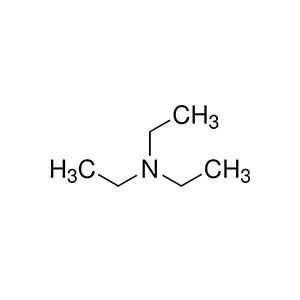Blog - Aure Chemical
Triethylamine CAS 121-44-8 | Industrial Uses, Properties & Structure
Triethylamine (TEA), known by its chemical identifier CAS 121-44-8, is a colorless, volatile liquid with a pungent, ammonia-like smell that might remind you of a strong cleaning product. As a tertiary amine, it plays a vital role in both industrial processes and laboratory experiments, acting like a versatile helper that speeds up reactions or neutralizes unwanted acidity. This blog post dives into TEA’s chemical properties, molecular structure, and its wide-ranging industrial applications, offering a clear guide for chemists, suppliers, and curious minds alike.
Chemical Identity
Basic Information

IUPAC Name: N,N-Diethylethanamine
CAS Number: 121-44-8
Molecular Formula: C6H15N
Synonyms: TEA, Triethylamin, N,N-Diethylamine
Molecular Structure
Triethylamine’s structure is like a tiny molecular tripod, with a nitrogen atom at the center bonded to three ethyl groups (think of them as three short carbon chains). This arrangement, with a molecular weight of 101.19 g/mol, gives TEA its unique chemical behavior. It appears as a colorless liquid, but its strong ammonia-like odor makes it unmistakable—like the sharp scent of a freshly opened bottle of household cleaner.
Chemical & Physical Properties
Here’s a snapshot of TEA’s key properties, presented like a recipe card for this chemical:
| Property | Value |
| Boiling Point | 89.5 °C |
| Melting Point | −114 °C |
| Density | 0.726 g/cm³ |
| Solubility in Water | Miscible |
| Flash Point | 27 °C (closed cup) |
| pKa (conjugate acid) | 10.75 |
| Refractive Index | 1.385 |
TEA is highly soluble in water, meaning it mixes as easily as sugar dissolves in hot tea. Its basicity (pKa 10.75) makes it a great neutralizer, like baking soda calming an acidic spill. However, its flammability (flash point 27 °C) and strong odor require careful handling, as it’s as volatile as gasoline in a hot environment.
Industrial and Laboratory Uses
Industrial Applications
Triethylamine is a chemical workhorse in industries. In pharmaceuticals, it’s a key ingredient in synthesizing active pharmaceutical ingredients (APIs), much like a chef adding a critical spice to a dish. It’s also used in producing pesticides and herbicides, ensuring crops stay protected. In manufacturing, TEA helps create coatings, resins, and adhesives—think of it as the glue that holds paint or sticky tape together. Additionally, it’s a go-to chemical for specialty products like silicones and polymers, which are found in everything from car parts to kitchenware.
Laboratory Applications
In labs, TEA is like a trusty assistant. It acts as a catalyst to speed up organic reactions, such as acylation or alkylation, similar to how a pinch of yeast helps dough rise faster. It also neutralizes acids during experiments, keeping reactions balanced, and finds use in analytical chemistry to fine-tune measurements, like a precise scale ensuring accurate recipe portions.
Trends and Relevance
The demand for TEA is growing, especially in pharmaceuticals and chemical manufacturing, driven by the need for new drugs and advanced materials. Emerging uses in polymer and silicone chemistry are also gaining traction, as industries innovate to create more durable, flexible products. As of 2025, the global triethylamine market is projected to reach around USD 660 million, with a CAGR of approximately 6% through 2033, influenced by steady supply chains and expanding applications in North America and beyond. It’s like TEA is becoming the Swiss Army knife of the chemical world, finding new roles in cutting-edge applications.
Handling and Safety Overview
Triethylamine is a flammable liquid and vapor with a strong, irritating odor that can clear a room faster than a skunk; it causes severe skin burns, eye damage, and may irritate the respiratory system. It reacts vigorously with acids and is harmful if swallowed or in contact with skin. Always wear personal protective equipment (PPE) like nitrile or neoprene gloves, goggles or a face shield, protective clothing, and respiratory protection in poorly ventilated areas—think of it as suiting up like a firefighter before tackling a blaze. Store TEA in a cool, well-ventilated area away from heat, sparks, open flames, and incompatible materials like strong oxidizers; keep containers tightly closed in approved flammable liquid cabinets. For detailed safety guidelines, consult the Material Safety Data Sheet (MSDS).
Suppliers and Market Overview
TEA is produced globally, with major suppliers in key regions offering high-purity grades (≥99%) for industrial and lab use. The market is influenced by supply-demand dynamics, with prices facing downward pressure in early 2025 due to ample ammonia supply, though overall growth remains positive.
| Region | Major Suppliers | Typical Purity |
| China | SinoChem, Aure Chemical | ≥99% |
| Europe | BASF, Merck | ≥99% |
| USA | Sigma-Aldrich, Spectrum Chemical | ≥99% |
Key Takeaways & Conclusion
Triethylamine (CAS 121-44-8) is a versatile tertiary amine with a simple yet effective molecular structure, making it indispensable in pharmaceuticals, coatings, and laboratory reactions. Its solubility, basicity, and reactivity make it a chemical multitool, but its flammability and strong odor demand cautious handling. For more in-depth insights, check out our related articles on the Triethylamine Safety Guide and Triethylamine Market Insights. Whether you’re a chemist or a supplier, understanding TEA’s properties and uses is key to leveraging its potential safely and effectively.
Related Articles
Looking for a reliable bulk supplier of Triethylamine?
Aure Chemical provides Premium Triethylamine (CAS 121-44-8).
View our Triethylamine product page
